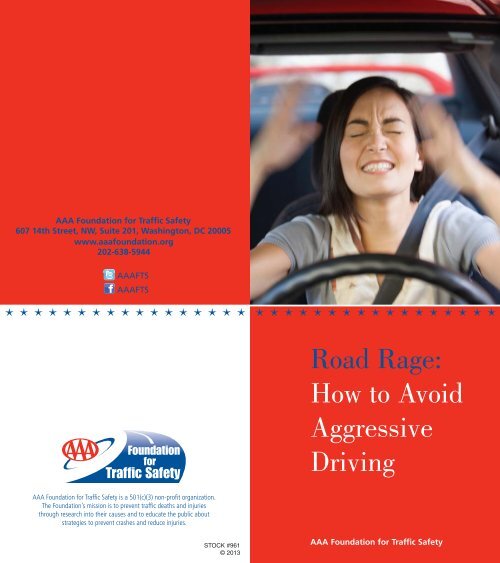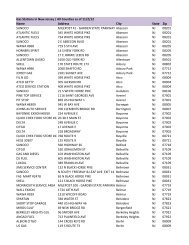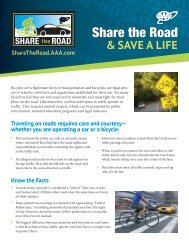Road Rage Brochure 2013 - AAA Exchange
Road Rage Brochure 2013 - AAA Exchange
Road Rage Brochure 2013 - AAA Exchange
- No tags were found...
You also want an ePaper? Increase the reach of your titles
YUMPU automatically turns print PDFs into web optimized ePapers that Google loves.
<strong>AAA</strong> Foundation for Traffic Safety607 14th Street, NW, Suite 201, Washington, DC 20005www.aaafoundation.org202-638-5944<strong>AAA</strong>FTS<strong>AAA</strong>FTS<strong>Road</strong> <strong>Rage</strong>:How to AvoidAggressiveDriving<strong>AAA</strong> Foundation for Traffic Safety is a 501(c)(3) non-profit organization.The Foundation’s mission is to prevent traffic deaths and injuriesthrough research into their causes and to educate the public aboutstrategies to prevent crashes and reduce injuries.STOCK #961© <strong>2013</strong><strong>AAA</strong> Foundation for Traffic Safety
Aggressive driving is a major concern of theAmerican public and a real threat to the safety ofall road users. In a survey conducted by the <strong>AAA</strong>Foundation, nearly 9 in 10 respondents said theybelieved aggressive drivers were a “somewhat”or “very serious” threat to their personal safety.This same survey found that a substantial numberof drivers admitted to engaging in potentiallyaggressive behaviors, such as traveling more than15 mph above the speed limit, or running a red light.By using the tips in this brochure,you can avoid becoming a victim.In the process you may find thatdriving has become a completely newand more enjoyable experience.Any unsafe driving behavior, performed deliberatelyand with ill intention or disregard for safety, canconstitute aggressive driving. In fact, a Foundationstudy found that potentially aggressive actions –such as tailgating, erratic lane changing, or illegalpassing – are a factor in up to 56% of fatal crashes.In extreme cases, this may escalate to road rage,which is a violent criminal act involving an intentionto cause physical harm. A separate <strong>AAA</strong> Foundationstudy looked at more than 10,000 road rageincidents committed over seven years, and foundthey resulted in at least 218 murders and another12,610 injury cases. When drivers explained whythey became violent, the reasons were often trivial:“She wouldn’t let me pass,” “They kept tailgatingme,” or, as this driver accused of attempted murderexplained, “He practically ran me off the road – whatwas I supposed to do?”<strong>AAA</strong> Foundation for Traffic Safety
How can you avoid being thevictim of an aggressive driver?Here are three basic guiding principlesthat can help:11. Don't offendWhen surveys ask drivers what angers them most,the results are remarkably consistent. A fewspecific behaviors seem unusually likely to enrageother drivers. You can protect yourself by avoiding them:Cutting off.When you merge, make sure you have plenty of room.Use your turn signal to show your intentions beforemaking a move. If you make a mistake and accidentallycut someone off, try to apologize to the other driverwith an appropriate gesture. If someone cuts you off,slow down and give them room to merge into your lane.Gestures.Almost nothing makes another driver angrier thanan obscene gesture. Keep your hands on the wheel.Avoid making any gestures that might anger anotherdriver, even “harmless” expressions of irritation likeshaking your head.Be a cautious and courteous driver. Signal every timeyou merge or change lanes, and whenever you turn.Use your horn rarely, if ever. If you and another driversee a parking space at the same time, let that personhave it. And if another driver seems eager to get infront of you, say “Be my guest.” When you respondthis way, after a while “be my guest” becomes yourautomatic response and you won’t be as offendedby other drivers’ rudeness.Driving slowly in the left lane.If you are in the left lane and someone wants to pass,move over and let them by. You may be “in the right”because you are traveling at the speed limit --- but youmay also be putting yourself in danger by makingdrivers behind you angry. In many states and provincesthe law requires you to travel in the right lane and usethe far left lane only for passing. Besides, it’s simplecourtesy to move over and let other drivers by.Tailgating.Drivers get angry when they are followed too closely.Allow at least a two-second space between your car andthe car ahead. [When you see the car pass a fixed point,you should be able to count at least “one-thousand,two-thousand” before you pass that point.]If you think another car is driving too slowly and youare unable to pass, pull back and allow more space,not less. That way if the car does something unexpectedyou will have time to get out of the way.You should be able to see the headlights of the carbehind you in your rear-view mirror. If you feel youare being followed too closely, signal and pull overto allow the other driver to go by.
2Don't engageOne angry driver can’t start a fight unlessanother driver is willing to join in. You canprotect yourself against aggressive drivers byrefusing to become angry at them. Orator RobertIngersoll said, “Anger blows out the lamp of themind.” When angry, a person can do things they maylater regret. If you’re tempted to retaliate againstanother driver, think: “Would I want to fly in anairplane whose pilot was acting like this?” Thinkabout what kind of a crash your angry actions couldcause. Then cool down and continue your trip.Steer clear.Give angry drivers lots of room. A driver you may haveoffended can “snap” and become truly dangerous.If the other driver tries to pick a fight, put as muchdistance as possible between your vehicle and theother car, and then get away as quickly as possible.Do not under any circumstances pull off to the sideof the road and try to settle things “man to man.”Avoid eye contact.If another driver is acting angry with you, don’t makeeye contact. Looking or staring at another driver canturn an impersonal encounter between two vehiclesinto a personal duel. And once things get personal,the situation can get out of hand fast.Get help.If you believe the other driver is following you or istrying to start a fight, get help. If you have a cellphone, use it to call the police. Otherwise, drive to aplace where there are people around, such as a policestation, convenience store, shopping center, or evena hospital. Use your horn to get someone’s attention.This will usually discourage an aggressor. Do not getout of your car. Do not go home.3Adjust your attitudeThe most important actions you can taketo avoid aggressive driving take place insideyour head. By changing your approach todriving, you can make every trip more pleasant.Try these ideas for a pleasant change:Forget winning.For too many motorists, driving becomes a contest.Do you allow the shortest possible time for a trip andthen race the clock? If something happens to slow youdown do you get angry? The solution: Allow more timefor your trip. You’ll be amazed at how much morerelaxed you feel when you have a few extra minutes.So instead of trying to “make good time,” try to“make time good.” Listen to soothing music or abook on tape. Practice relaxation techniques, such asdeep breathing. You’ll arrive much calmer, fresher,and in a less stressed-out frame of mind.Put yourself in the other driver’s shoes.Instead of judging the other driver, try to imagine whyhe or she is driving that way. Someone speeding andconstantly changing lanes may be a volunteer fireman,or a physician rushing to a hospital. Someone who jerksfrom one lane to another may have a bee in the car ora crying baby. Whatever their reason, it has nothing todo with you. Stay cool and don’t take other drivers’actions personally.If you think you have a problem, ask for help.Courses in anger management have been shown toreduce heart attacks. These same techniques can alsohelp angry drivers. Drivers who successfully “reinvent”their approach to the road report dramatic changesin attitude and behavior. Look for anger managementcourses in your area. Self-help books on stress reductionand anger management can also be helpful.




